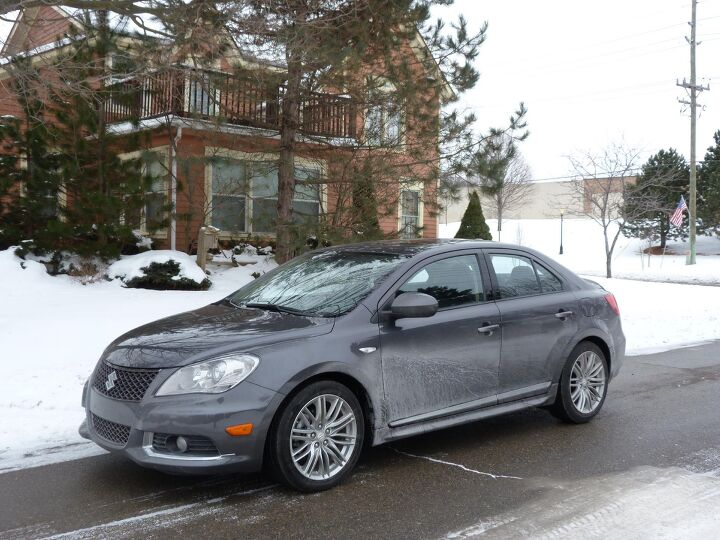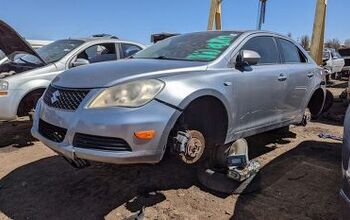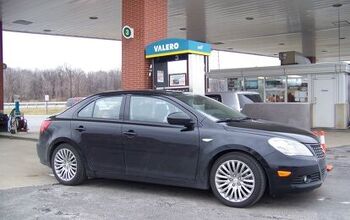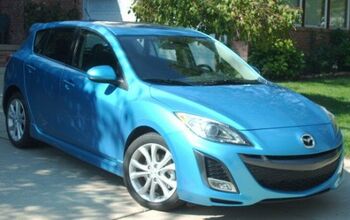Review: 2011 Suzuki Kizashi Sport
Maybe it was my lukewarm review. Or maybe it was because Suzuki’s most ardent attempt to date to appeal to Americans connected with only 6,138 of them last year. Despite the unintended acceleration media circus, Toyota sold more Camrys in the average week. Whatever the reason, Suzuki revised the Kizashi after just one model year, transforming the two top trim levels into “Sport” models. Substitute a six-speed manual and front-wheel-drive for the previous test’s CVT and all-wheel-drive, and the 2011 Kizashi certainly deserves another look.
The Kizashi’s sheetmetal hasn’t changed, so the exterior styling remains much less distinctive than the car’s name suggests it ought to be. That said, the “Sport” tweaks—a tasteful body kit, thinner-spoked wheels—highlight the car’s tight, athletic proportions and make its exterior almost memorable. I remain thankful that the then-new corporate front end introduced with the 2007 XL7 went no further than that SUV. Still, something about this car should mark it as a Suzuki, aside from the oversized S on the grille.
For a car priced in the mid-20s, the Kizashi continues to have an exceedingly well-appointed interior. Luxuriously upholstered door panels, a woven headliner, switchgear that’s a cut or two above the mid-20s norm, compartment lids that open with a dampened glide, and thorough red backlighting all contribute to a look and feel suitable to a car costing at least $10,000 more. Once the benchmark, the latest Volkswagen sedan interiors aren’t even close. The “Sport” revisions include a mildly restyled steering wheel and white stitching on the black leather seats. The latter serves to lighten up the almost overwhelmingly black interior. Would red stitching have been sportier, or at this point too much of a cliché?
Suzuki similarly aims to impress with the Kizashi’s features list, and generally succeeds. Especially nice to see at a $26,000 price: three-stage heated leather power front seats, memory for the driver’s seat, a 425-watt Rockford Fosgate sound system, keyless access and ignition, rain-sensing wipers, and rear air vents.
Even before this year’s “Sport” revisions, Suzuki pitched the Kizashi as a driver’s car. The firm-yet-comfortable front buckets fit the bill, with side bolsters that (for once) actually provide even better lateral support than their appearance suggests they will. Size-wise, the Kizashi falls between a compact and a midsize, but this didn’t dissuade Suzuki from fitting seats a little larger than most these days, further contributing to the car’s premium feel.
The not-quite-midsize dimensions translate to a rear seat that is just large enough for the average adult. Those six-feet and up will wish for a true midsize. Kids, on the other hand, will wish for a lower beltline. In the Kizashi they struggle to see out. The driver fares a bit better, though the cowl is a bit high, the A-pillars are on the thick side, and the wheel must to tilted up a notch to avoid obstructing the classic white-on-black instruments.
When paired with the six-speed manual transmission and front-wheel-drive, the Kizashi’s 2.4-liter four-cylinder engine kicks out another 5 horsepower, for a total of 185 at 6,500 rpm, and must motivate about 240 fewer pounds, for a total around 3,250. So with a manual transmission the Kizashi is significantly quicker, and feels it. There’s not much power below the 4,000 rpm torque peak (where 170 foot-pounds can be found), so downshifts are a must for brisk acceleration. But in this powertrain the four sounds and feels smoother, with a pleasant zing, so winding it out is a joy. Even though the manual shifter is easily the least refined part of the car, with a clunky, sometimes even balky action, it’s far more enjoyable than the paddle-shiftable CVT.
Still missing, though much less missed with the stick: a more powerful optional engine.
The EPA rates the manual for 20 MPG city and 29 highway, compared to 23/30 with the CVT. The trip computer was wildly optimistic, reporting high 20s and low 30s in the suburbs and 42.6 on one trip, averaging 55 miles-per-hour with a single complete stop. I used a little over half of the 16.6-gallon tank in 176 miles, so the EPA numbers are probably about right.
Last year I suggested that the Kizashi’s chassis needed another round of tuning. With the “Sport,” it got it. Though the changes aren’t dramatic, the revised car handles more sharply and precisely, if still not quite as intuitively as the best sport sedans. Feedback through the steering wheel is subtle, but it’s there. The steering in a Buick Regal turbo (driven while I had the Kizashi) feels light and numb in comparison. The occasional float noted at highway speeds last year is gone, and the “Sport” generally feels more tied down. Better damping than anything from Korea contributes to very good body control when the pavement diverges from level and smooth. With the possible exception of the first-generation Acura TSX, no Japanese sedan has felt more European. The more I drove the Kizashi Sport SLS, the more I liked it.
One mild reservation: the Dunlop SP Sport 7000s might be rated “all-season” tires, but their traction on snow is marginal. The stability control system doesn’t jump in too soon, and when it does operates unobtrusively. Turn it off and the Kizashi remains easy to control even on slick surfaces.
Even with the “Sport” tuning, the Kizashi’s ride remains quiet and polished. Though it can feel a little bumpy in casual driving on some roads, the motions are restrained and vertical rather than poorly controlled and head-tossing. Push the car more aggressively, and the tuning feels spot-on. Highly effective insulation often makes the car seem like it’s going 20 miles-per-hour slower than it actually is. Though this impacts driving enjoyment a bit, it’s a big plus on the highway.
With metallic paint, floormats, and satellite radio, the Kizashi Sport SLS lists for $26,049. (If you can do without heated leather seats and a few other features, you can save $1,800 with the Sport GTS.) The new Jetta GLI will cost about the same as the Sport SLS, but while it will be quicker it looks and feels like a much cheaper car. An Acura TSX is much closer in terms of size, materials, features, and performance—and lists for $4,421 more than the Suzuki. Adjust for remaining feature differences, and according to TrueDelta’s car price comparison tool the non-premium-branded car’s advantage actually increases, to over $5,000. Add in the Suzuki’s 7/100 powertrain warranty that, unlike Hyundai’s, is transferable, and the car is clearly a very good value.
“Kizashi” means “something great is coming.” With the “Sport” revisions, greatness might still not have arrived, but it’s certainly closer. The Suzuki’s exterior and interior dimensions resemble those of the B5 Volkswagen Passat and the first-generation Acura TSX, both of which appealed to people who wanted enough room for adults in the back seat without the bulk of a truly midsize sedan. The Kizashi’s features, materials, seats, ride, and overall refinement are all those of a much more expensive car, and not those of a compact sedan. The engine isn’t any more powerful this year, but (as is often the case) the manual transmission is worth about 50 horsepower in terms of driving enjoyment. The “Sport” tweaks subtly yet significantly upgrade the exterior appearance and the handling. Add it all up and, in Sport SLS trim with a manual transmission, the 2011 Kizashi is definitely worthy of consideration by enthusiasts searching for the attributes of a European sport sedan without a European price.
Suzuki provided the vehicle, insurance and one tank of gas for this review.
Michael Karesh operates TrueDelta, an online source of automotive pricing and reliability data.
Michael Karesh lives in West Bloomfield, Michigan, with his wife and three children. In 2003 he received a Ph.D. from the University of Chicago. While in Chicago he worked at the National Opinion Research Center, a leader in the field of survey research. For his doctoral thesis, he spent a year-and-a-half inside an automaker studying how and how well it understood consumers when developing new products. While pursuing the degree he taught consumer behavior and product development at Oakland University. Since 1999, he has contributed auto reviews to Epinions, where he is currently one of two people in charge of the autos section. Since earning the degree he has continued to care for his children (school, gymnastics, tae-kwan-do...) and write reviews for Epinions and, more recently, The Truth About Cars while developing TrueDelta, a vehicle reliability and price comparison site.
More by Michael Karesh
Latest Car Reviews
Read moreLatest Product Reviews
Read moreRecent Comments
- SCE to AUX I don't really understand what this money does, but if it's for The Children, then I'm all for it.
- Redapple2 Super looking. 4000lbs and $75,000 out the door and i d be tempted.
- SCE to AUX Agree 100%.But I'm not sure how rare false positives are. My rental Model 3 hit the brakes twice during the week I had it - very unnerving at highway speeds. I think I disabled it once I found the setting inside the terrible menu system.Even my Santa Fe had this problem in stop-and-go traffic, and I disabled it.So what's the benefit of a poor driving aid that makes people want to disable it?
- Mike Beranek No interior pictures usually means that the interior looks like death warmed over.
- Kwik_Shift_Pro4X Oof. (again)Not looking good.
















































Comments
Join the conversation
I know I'm a little late to this party, but I just traded my Veloster, for a 2012 Kizashi GTS AWD. I think I'm in love with my car. Sounds like an old tune by Queen. It tops my Veloster in every way possible, except mpg's, and is a much more pleasing car to drive. I'm in Pittsburgh, and regretted trading my Suzuki SX4 for a Veloster after about 5 months, and a few inches of snow. I expect the Kizashi will be much better in the snow than the SX4 (which was very capable), but needed just a bit more power.
I would so love to find one of these, but I'd bet there were maybe 5 or 10 6-speeds ordered in the whole damn country. In 2011. Sure I'm gonna find one.